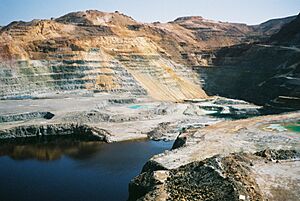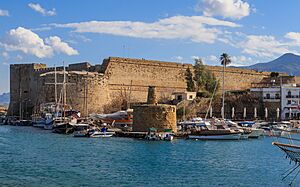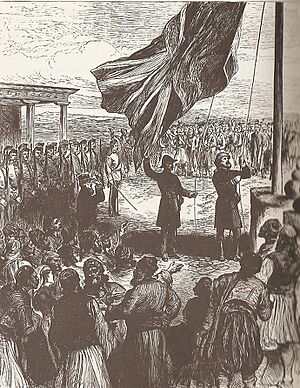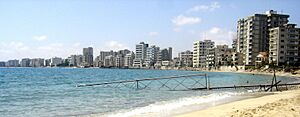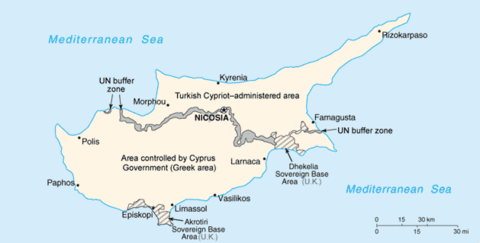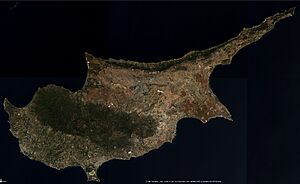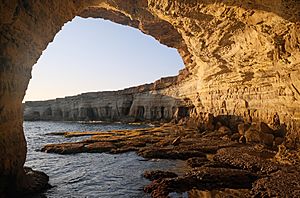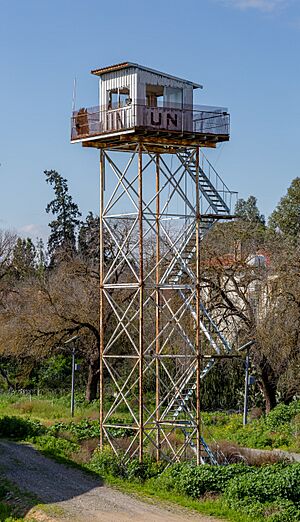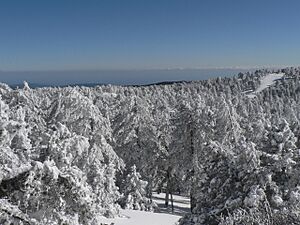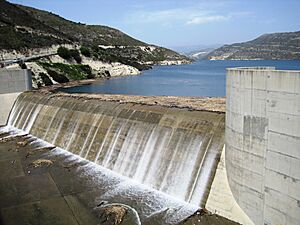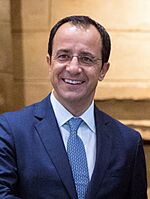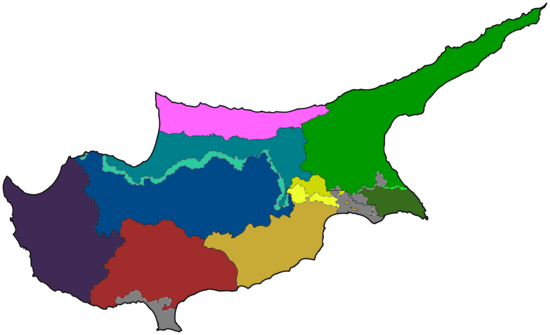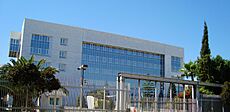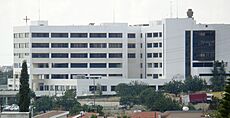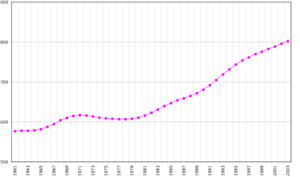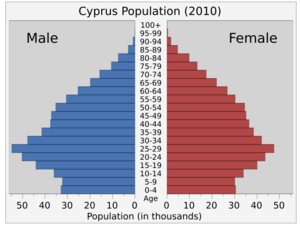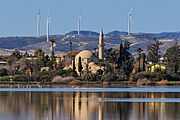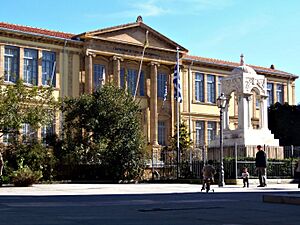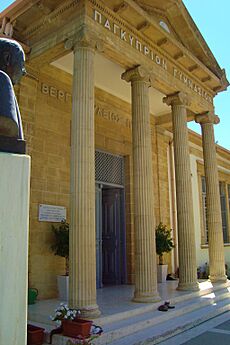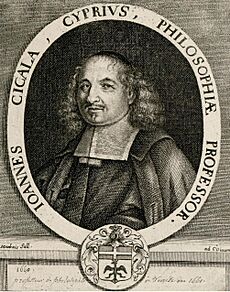Cyprus facts for kids
Quick facts for kids
Republic of Cyprus
|
|
|---|---|
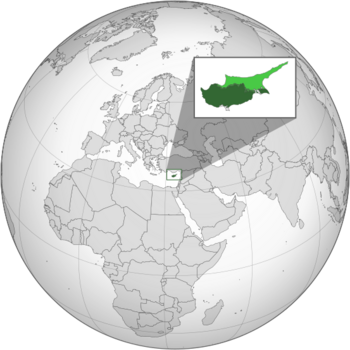
Location of the Republic of Cyprus in dark green, territory de jure but not controlled in light green
|
|
| Capital and largest city
|
Nicosia 35°10′N 33°22′E / 35.167°N 33.367°E |
| Official languages | |
| Minority languages |
|
| Vernaculars |
|
| Ethnic groups |
|
| Religion
(2020; including Northern Cyprus)
|
|
| Demonym(s) | Cypriot |
| Government | Unitary presidential republic |
| Nikos Christodoulides | |
| Vacant | |
| Annita Demetriou | |
| Legislature | House of Representatives |
| Independence from the United Kingdom | |
| 19 February 1959 | |
|
• Independence proclaimed
|
16 August 1960 |
|
• Independence Day
|
1 October 1960 |
| Area | |
|
• Total
|
9,251 km2 (3,572 sq mi) (162nd) |
|
• Water (%)
|
0.11 |
| Population | |
|
• 2021 census
|
|
|
• Density
|
123.4/km2 (319.6/sq mi) (82nd) |
| GDP (PPP) | 2024 estimate |
|
• Total
|
|
|
• Per capita
|
|
| GDP (nominal) | 2024 estimate |
|
• Total
|
|
|
• Per capita
|
|
| Gini (2022) | low |
| HDI (2022) | very high · 29th |
| Currency | Euro (€) (EUR) |
| Time zone | UTC+02:00 (EET) |
|
• Summer (DST)
|
UTC+03:00 (EEST) |
| Driving side | left |
| Calling code | +357 |
| ISO 3166 code | CY |
| Internet TLD | .cy |
Cyprus , officially the Republic of Cyprus, is an island country in the eastern Mediterranean Sea. It's a unique place because it's geographically in West Asia, but its culture and politics are very much like Southeast Europe. Cyprus is the third largest and third most populated island in the Mediterranean. It's located east of Greece, north of Egypt, south of Turkey, and west of Lebanon and Syria. Its capital and largest city is Nicosia. Cyprus also shares land borders with Akrotiri and Dhekelia, which are special territories belonging to the United Kingdom. A part of the island in the northeast is controlled by the self-declared Turkish Republic of Northern Cyprus.
People first lived in Cyprus about 13,000 years ago. Farming communities started appearing a few thousand years later. In the late Bronze Age, Cyprus became an important trading hub, especially for copper. Over time, different powerful groups ruled Cyprus, including the Mycenaean Greeks, Assyrians, Egyptians, Persians, and later Alexander the Great. After Alexander, it was ruled by Egypt, then the Romans and By Byzantines. Later, the French Lusignan dynasty and the Venetians took over, followed by more than 300 years of Ottoman rule until 1878. Then, the United Kingdom took control in 1878 and officially made it a British colony in 1914.
After World War II, the people of Cyprus wanted to decide their own future. The Greek Cypriots wanted to unite with Greece, a movement called enosis. The Turkish Cypriots first wanted to stay under British rule, then wanted the island to be divided, with a Turkish part in the north, a policy called taksim. After some fighting in the 1950s, Cyprus became independent in 1960. More fighting happened in 1963–64, which led to many Turkish Cypriots moving into separate areas. In 1974, there was a coup attempt by Greek Cypriots, which led to the Turkish invasion of Cyprus. This resulted in the island being divided, with the northern part becoming the self-declared Turkish Republic of Northern Cyprus in 1983. Most countries in the world do not recognize this state. These events are still part of a continuing disagreement.
Today, Cyprus is a popular place for tourists and has a strong economy. The Republic of Cyprus joined the Commonwealth in 1961 and became a member of the European Union on May 1, 2004. On January 1, 2008, Cyprus started using the euro currency.
Contents
What's in a Name? The Etymology of Cyprus
The name Cyprus has a long history. The oldest known mention is from about 3,500 years ago in ancient Greek writings, meaning "Cypriot."
The exact origin of the name is not fully known, but there are a few ideas:
- It might come from the Greek word for the Mediterranean cypress tree (kypárissos).
- It could be from the Greek name for the henna tree (kýpros).
- A popular idea is that it comes from an ancient word for copper. Cyprus was famous for its large copper mines, and the island's name even gave us the Latin word for copper, Cuprum, which is where the chemical symbol for copper, Cu, comes from!
People from Cyprus are called Cypriots.
A Look Back: The History of Cyprus
Early Settlers and Ancient Times
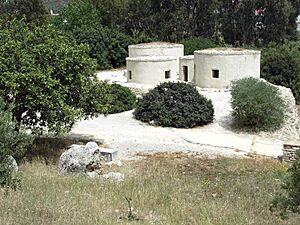
The first hunter-gatherers arrived in Cyprus about 13,000 to 12,000 years ago. Interestingly, their arrival happened around the same time that the island's unique small hippos and dwarf elephants disappeared. About 10,500 years ago, farming communities started to appear.
At one ancient site in Cyprus, archaeologists found an eight-month-old cat buried with a human body. This grave is about 9,500 years old, which means cats and humans were connected much earlier than we thought! The ancient village of Khirokitia is a UNESCO World Heritage Site and dates back to around 6800 BC.
During the Late Bronze Age (around 1650 BC), Cyprus became very important in the Mediterranean world. This was because of the copper found in the Troodos Mountains. This trade helped cities grow across the island. Records show that kings ruled Cyprus and communicated with leaders from other powerful places like ancient Egypt.
Later, around 1100-1050 BC, many Greeks settled on the island. This is why Cyprus has a strong Greek character today. In Greek mythology, Cyprus is famous as the birthplace of the goddess Aphrodite.
Because of its location, Cyprus was often ruled by different empires. It was controlled by the Neo-Assyrian Empire, then briefly by Egypt, and later by the Persians. In 333 BC, Alexander the Great conquered the island. After Alexander's death, Cyprus became part of the Egyptian empire ruled by the Ptolemies. During this time, the island became even more Greek in its culture. In 58 BC, Cyprus became part of the Roman Republic.
Cyprus in the Middle Ages
When the Roman Empire split in 286 AD, Cyprus became part of the East Roman Empire, also known as the Byzantine Empire. It stayed under Byzantine rule for about 900 years. During this long period, Cyprus developed its strong Greek-Christian identity.
From 649 AD, Cyprus faced many attacks from Arab forces. These attacks caused a lot of damage and poverty. In 688 AD, a special agreement was made where Cyprus would pay tribute to both the Byzantines and the Arabs, remaining neutral. Full Byzantine rule returned in 965 AD.
In 1191, during the Third Crusade, Richard I of England (Richard the Lionheart) captured the island. He later sold it to the Knights Templar, a military order. After a revolt, the Templars sold it to Guy of Lusignan. His family, the Lusignans, ruled Cyprus as a kingdom for a long time.
After the last Lusignan king died in 1473, the Republic of Venice took control of Cyprus in 1489. The Venetians built strong defenses, like the Walls of Nicosia, to protect the cities. They used Cyprus as an important trading center.
Ottoman Rule in Cyprus
In 1570, the Ottoman Empire launched a huge attack with 60,000 soldiers and took control of the island. Many Greek and Armenian Christians were killed. This conquest brought a big change to the island's population, as many Ottoman soldiers and Turkish people from Anatolia settled there, forming a new Muslim community.
The Ottomans changed the way Cyprus was governed. They used the millet system, which allowed non-Muslims to be governed by their own religious leaders. The head of the Church of Cyprus became the leader of the Greek Cypriot population, acting as a link between them and the Ottoman rulers.
Over the centuries, the number of Muslims and Christians on the island changed. By 1872, out of 144,000 people, about 100,000 were Christians and 44,000 were Muslims. Some Muslims were actually crypto-Christians who secretly practiced Christianity.
When the Greek War of Independence started in 1821, some Greek Cypriots went to Greece to fight. In response, the Ottoman governor in Cyprus arrested and executed many important Greek Cypriots, including the Archbishop. This led to a stronger desire among Greek Cypriots for enosis, or union with Greece.
British Rule in Cyprus
In 1878, the British Empire took over the administration of Cyprus, though it officially remained Ottoman territory until 1914. Britain wanted Cyprus as a military base to protect its trade routes, especially the Suez Canal. When the Ottoman Empire joined World War I against Britain, the British formally annexed Cyprus in 1914.
In 1923, after the war, Turkey gave up all claims to Cyprus in the Treaty of Lausanne. In 1925, Cyprus became a British crown colony. During World War II, many Greek and Turkish Cypriots joined the British forces.
Greek Cypriots hoped that British rule would lead to enosis (union with Greece). This idea was supported by the Cypriot Orthodox Church. In the 1950s, a group called EOKA started an armed struggle for union with Greece.
Turkish Cypriots were worried about enosis. They saw what happened in Crete, where many Turks left after it united with Greece. So, they started to support the idea of dividing the island, or Taksim. In the 1950s, a Turkish Cypriot group called TMT was formed to counter EOKA.
The Division of Cyprus (1974)
On July 15, 1974, a coup d'état took place in Cyprus, aiming to unite the island with Greece. Five days later, on July 20, 1974, the Turkish army invaded the island. They said they were acting to restore the constitutional order, but the United Nations and other countries did not agree.
The Turkish forces bombed Greek positions and landed troops. After a ceasefire, Turkey launched a second invasion, taking control of more areas. As a result, about 36% of the island came under Turkish control. Many Greek Cypriots had to leave their homes in the north, and about 50,000 Turkish Cypriots moved to the north.
The Republic of Cyprus still officially controls the entire island, except for the British military bases. However, the island is effectively divided into two main parts: the south, controlled by the Republic of Cyprus (about 59% of the island), and the north, controlled by the self-declared Turkish Republic of Northern Cyprus (about 36%). There is also a UN buffer zone separating the two parts. Most of the world sees the northern part as territory of the Republic of Cyprus that is occupied by Turkish forces.
Cyprus Today
After the 1974 events, Turkish troops remained in the northern part of the island. In 1983, the Turkish Cypriot leaders declared the Turkish Republic of Northern Cyprus (TRNC), but only Turkey recognizes it.
The events of 1974 still greatly affect the politics of Cyprus and relations between Greece and Turkey. There have been many attempts to solve the Cyprus dispute. In 2004, a plan called the Annan Plan was put to a vote. 65% of Turkish Cypriots voted for it, but 74% of Greek Cypriots voted against it, feeling it was unfair.
On May 1, 2004, Cyprus joined the European Union. The EU considers Cyprus as a whole, but its laws are not applied in Northern Cyprus until the dispute is resolved.
Efforts have been made to allow people to move more freely between the two sides. In 2003, Northern Cyprus eased checkpoint rules. In 2008, a wall in Ledra Street in Nicosia, which had divided the capital for decades, was taken down, and the street was reopened. Talks to reunite the island restarted in 2015 but ended in 2017.
In July 2024, on the 50th anniversary of the Turkish invasion, the Turkish President suggested having two separate states in Cyprus. Greek Cypriots immediately rejected this idea.
Exploring the Geography of Cyprus
Cyprus is the third largest island in the Mediterranean Sea, after Sicily and Sardinia. It is about 240 kilometers (150 miles) long and 100 kilometers (62 miles) wide at its widest point. Turkey is about 75 kilometers (47 miles) to the north. Cyprus is located at a meeting point of three continents: Europe, Asia, and Africa.
The island has two main mountain ranges: the Troodos Mountains and the smaller Kyrenia Range. Between them is a central plain called the Mesaoria. The highest point in Cyprus is Mount Olympus, which is 1,952 meters (6,404 feet) high, located in the Troodos range.
Politically, the island is divided into four main parts:
- The Republic of Cyprus controls the southern two-thirds (about 60%).
- The Turkish Republic of Northern Cyprus controls the northern third (about 35%).
- The UN Green Line separates the two parts (about 2.7%).
- Two British military bases, Akrotiri and Dhekelia, cover the remaining 2.7%.
Cyprus Climate
Cyprus has a Mediterranean climate, with very mild winters along the coast and warm to hot summers. Snow only falls in the Troodos Mountains. Most of the rain happens in winter, and summers are usually dry.
Cyprus has one of the warmest climates in the European Union. The average temperature on the coast is around 24°C (75°F) during the day. Summers last about eight months, from April to November.
The island gets a lot of sunshine, about 3,200 hours per year. This is much more than many cities in northern Europe.
Water Supply in Cyprus
Cyprus often faces a shortage of water. The country relies a lot on rainfall, but average yearly rainfall has decreased over the past 30 years.
Dams are the main source of water for homes and farms. Cyprus has 108 dams and reservoirs. To help with droughts, the government has built desalination plants, which turn seawater into fresh water. These plants now provide almost half of the domestic water supply.
Turkey has also built a pipeline under the Mediterranean Sea to supply water to Northern Cyprus.
Flora and Fauna
Cyprus is home to several unique species found nowhere else in the world. These include the Cypriot mouse, the golden oak tree, and the Cyprus cedar tree.
How Cyprus is Governed
Cyprus is a presidential republic. This means the President is both the head of state and the head of government. The president is elected by the people for a five-year term. The government handles executive power, while the House of Representatives makes the laws. The courts are independent.
The original 1960 Constitution set up a system with a Greek Cypriot president and a Turkish Cypriot vice-president. They both had veto power over certain laws. However, after clashes between the two communities in 1965, the Turkish Cypriot seats in the House have remained empty.
Today, the House of Representatives has 56 members elected for a five-year term. There are also three observer members representing the Armenian, Latin, and Maronite minorities. The United Nations recognizes the Republic of Cyprus's authority over the entire island.
Regions of Cyprus
The Republic of Cyprus is divided into six main areas called districts: Nicosia, Famagusta, Kyrenia, Larnaca, Limassol, and Paphos.
Cyprus and Other Countries
Cyprus is a member of many international organizations, including the Commonwealth, the Council of Europe, and the European Union. It is also a member of the United Nations.
In 2024, Cyprus was ranked as the 88th most peaceful country in the world.
Military of Cyprus

The Cypriot National Guard is the main military force of the Republic of Cyprus. It includes land, air, and naval units. Historically, all male citizens had to serve for 24 months after their 17th birthday. In 2016, this service was reduced to 14 months.
Law and Justice
The Cyprus Police is the national police service. It works under the Ministry of Justice and Public Order.
Cyprus is considered a "free" country by Freedom House, meaning it has good freedom of speech and press. The government generally respects these rights.
The Economy of Cyprus
In the early 2000s, Cyprus had a strong economy based on services, making it one of the wealthiest countries to join the European Union in 2004. However, the global financial crisis and the Eurozone crisis later affected Cyprus.
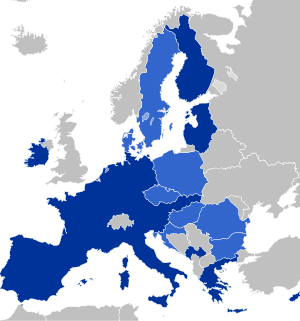
In 2013, Cyprus received a large loan from the European Commission, the European Central Bank, and the International Monetary Fund. In return, the government had to make some changes to its banks.
Despite these challenges, Cyprus made a strong economic recovery. By 2023, its GDP per person was among the highest in Southern Europe. Tourism, financial services, and shipping are very important parts of the economy. Cyprus is also known for its low tax rates, which attract many businesses. The Cypriot government adopted the euro currency on January 1, 2008.
Recently, large amounts of natural gas have been found offshore in Cyprus's waters. This could be a big boost for the economy. Cyprus has agreements with Egypt, Lebanon, and Israel about its maritime borders.
Getting Around: Infrastructure
Cyprus is one of only three EU countries where vehicles drive on the left-hand side of the road, a leftover from British rule. There are good motorways connecting cities along the coast and inland to Nicosia.
Cyprus has two international airports in the government-controlled areas: one in Larnaca (the busiest) and one in Paphos. The main ports are Limassol and Larnaca, which handle cargo, passengers, and cruise ships.
Cyta, a state-owned company, manages most phone and internet connections. However, there are now several private companies too.
People and Culture of Cyprus
Population and Languages
According to the 2021 Census, the population in the government-controlled areas was 918,100. Nicosia is the most populated district.
In 1960, after independence, Cyprus had a total population of 573,566. About 77% were Greeks, 18% were Turks, and 5% were other groups. Due to past tensions, island-wide censuses have been difficult.
Cyprus has two official languages: Greek and Turkish. Armenian and Cypriot Maronite Arabic are also recognized as minority languages. English is widely spoken and used in public signs. In 2010, over 80% of Cypriots could speak English as a second language. Russian is also commonly spoken, especially in Limassol and Paphos.
The everyday language of Greek Cypriots is Cypriot Greek, and for Turkish Cypriots, it's Cypriot Turkish. These are slightly different from the standard Greek and Turkish languages.
Religion in Cyprus
| Religion in Cyprus (Pew Research) | ||||
|---|---|---|---|---|
| Religion | Percent | |||
| Eastern Orthodoxy | 78% | |||
| Islam | 20% | |||
| Other | 1% | |||
| None | 1% | |||
Most Greek Cypriots are Christians, specifically Greek Orthodox. Most Turkish Cypriots follow Sunni Islam. The first President of Cyprus, Makarios III, was an archbishop.
A famous Muslim pilgrimage site, Hala Sultan Tekke, is located near the Larnaca Salt Lake.
Education in Cyprus
Cyprus has a very good education system, with both public and private schools. A large portion of the country's money (about 7% of its GDP) is spent on education, which is one of the highest rates in the EU. Cyprus was ranked 27th in the Global Innovation Index in 2024.
Many Cypriots go to universities in Greece, the UK, Turkey, other European countries, and North America. Cyprus has the highest percentage of working-age citizens with higher education in the EU.
Cyprus Culture and Traditions
Greek and Turkish Cypriots share many cultural similarities, like traditional foods and drinks, and a strong sense of hospitality. Music, dance, and art are important parts of social life for both groups. Traditional dances like the tsifteteli are common. However, their religions are different, with Greek Cypriots being Greek Orthodox and Turkish Cypriots being Sunni Muslims.
The Limassol Carnival Festival is a popular annual event held in Limassol.
Arts and Crafts

Cyprus has a long history of art, going back 10,000 years. The island has many beautiful religious icons and painted churches from the Middle Ages. Cypriot architecture was influenced by French Gothic and Italian Renaissance styles during the time of Latin rule.
A well-known traditional craft is Lefkara lace, which comes from the village of Lefkara. This lace is recognized by UNESCO for its unique designs and detailed production. Another art form from Lefkara is Cypriot Filigree, which is delicate jewelry made from twisted silver threads.
Modern Cypriot art began with painters like Vassilis Vryonides. Many Cypriot artists still train in England or at art schools in Greece and Cyprus.
Music of Cyprus
Traditional folk music in Cyprus shares elements with Greek, Turkish, and Arabic music. It includes dances like the tillirkotissa and the Middle Eastern-inspired tsifteteli. There's also a musical poetry style called chattista. Common instruments include the violin, lute, Cyprus flute, oud, and percussion.
Popular music in Cyprus is often influenced by Greek Laïka music. There's also a growing hip hop, R&B, and reggae scene. Cypriot rock music is also popular.
Literature and Stories
Ancient Cypriot literature includes the Cypria, an epic poem from the 7th century BC. Zeno of Citium, a Cypriot, founded the Stoic school of philosophy.
During the Middle Ages, epic poems were popular. Two important chronicles tell the history of Cyprus until the end of Frankish rule. Love poems written in medieval Greek Cypriot also exist from the 16th century.
Modern Greek Cypriot writers include poets and authors like Costas Montis. Some folk poets wrote in the Cypriot-Greek dialect. Leading Turkish Cypriot writers include Osman Türkay, who was nominated for the Nobel Prize in Literature twice.
Cyprus has also appeared in foreign literature. Most of William Shakespeare's play Othello is set on the island. British writer Lawrence Durrell lived in Cyprus and wrote the book Bitter Lemons about his experiences there.
Media and News
In 2015, reports rated the Republic of Cyprus and Northern Cyprus as having "free" press. The law protects freedom of speech and the press, and these rights are generally respected.
Local TV companies include the state-owned Cyprus Broadcasting Corporation. There are also many private channels.
Cypriot Food

During the medieval period, under the French Lusignan kings, a special courtly cuisine developed in Cyprus, mixing French, Byzantine, and Middle Eastern styles. Some of these recipes, known as vyands de Chypre (foods of Cyprus), became popular in Europe.
One example of a Cypriot food that became known in Europe is the cauliflower. Arab botanists in the 12th and 13th centuries believed it originated in Cyprus, and it was sometimes called "Cyprus cabbage."
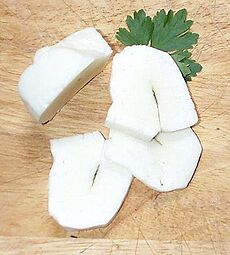
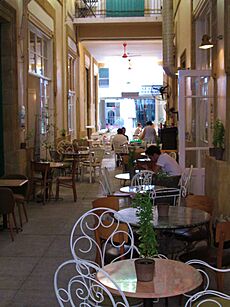
Even after the Ottomans took over in 1571, some Lusignan-era dishes survived. These include different kinds of tahini and hummus.
Halloumi cheese is very famous and is thought to have originated in Cyprus. It's often served grilled or fried as an appetizer.
Cypriot cuisine also features seafood like squid and red mullet. Common vegetable dishes include potatoes with olive oil, pickled cauliflower, and taro. Traditional meat dishes include lountza (smoked pork loin), charcoal-grilled lamb, souvlaki (pork and chicken skewers), and sheftalia (minced meat sausages). Pourgouri (cracked wheat) is a common side dish.
Fresh fruits and vegetables are widely used. Popular fruits include pears, apples, grapes, oranges, figs, watermelon, and lemons.
Cyprus is also known for its desserts, like lokum (Turkish delight) and Soutzoukos. The lokum from the village of Geroskipou has a special protected status.
Sports in Cyprus

Sports in Cyprus are managed by various organizations, including the Cyprus Football Association and the Cyprus Basketball Federation.
Famous sports teams include APOEL FC, Anorthosis Famagusta FC, and AEL Limassol FC. The GSP Stadium is the largest stadium in the Republic of Cyprus-controlled areas.
In the 2008–09 season, Anorthosis Famagusta FC was the first Cypriot team to reach the UEFA Champions League Group stage. The next season, APOEL FC also qualified and even reached the quarterfinals of the 2011–12 UEFA Champions League.
The Cyprus national rugby union team, nicknamed The Moufflons, holds a record for most consecutive international wins.
Individual Cypriot athletes have also achieved success. Footballer Sotiris Kaiafas won the European Golden Shoe in 1975–76. Tennis player Marcos Baghdatis was ranked 8th in the world in 2006. High jumper Kyriakos Ioannou won a bronze medal at the World Championships in 2007.
Cyprus won its first ever Olympic medal, a silver, in sailing at the 2012 Summer Olympics, thanks to Pavlos Kontides.
Images for kids
-
The Armenian Alphabet at the Melkonian Educational Institute. Armenian is recognised as a minority language in Cyprus.
See also
 In Spanish: Chipre para niños
In Spanish: Chipre para niños
- Ancient regions of Anatolia
- Index of Cyprus-related articles
- Outline of Cyprus
- List of notable Cypriots




